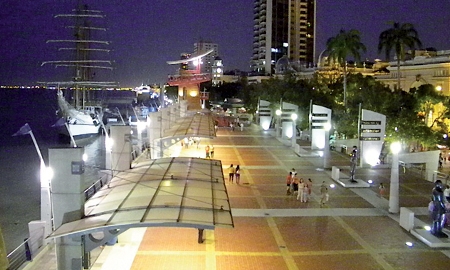Though neither its industrial hub nor its political center, Guayaquil is Ecuador’s most populated city and its economic heart. The very identity of the Guayaquileños is commerce-oriented; perhaps it is the port itself that has ingrained business in their blood.
Either way, the city has long been an economic stronghold and in recent years, Jaime Nebot – Mayor since 2000 – has commissioned numerous projects to beautify the city and turn it into a top tourist and business destination. In doing so, he’s also created a framework of safety and political stability for investments.
In what has been dubbed a case study for urban regeneration, Guayaquil’s transformation has made it safer, cleaner and with a wider cultural offering.
One of the first and most noteworthy changes was that made to the city’s river front. A boardwalk project called Malecón 2000 replaced the old dilapidated one that had fallen into such disrepair that it eventually fell into the river. Consequently, the area became a haven for thieves and drug dealers.
Malecón 2000 was finished in 1999 and features plazas, fountains, parks and recreational areas, museums, an IMAX theater, sculptures and monuments, a shopping center, exhibition areas, and restaurants. Ranked among the most visited places in the city, the boardwalk is one of the largest projects ever undertaken in Guayaquil and was declared a healthy public space by the World Health Organization.
The city government has not stopped there, however. Another riverfront project, Ciudad del Río is currently being built by local real estate developer Pronobis – the name behind many of the city’s other tourism, commercial and residential properties.
At a cost of $200 million, the white and black Ciudad del Río will be the new home of a five-star Wyndham Hotel, a shopping mall, condominiums, and a business center and offices (housed in the 34-storey tall iconic tower, The Point), among other things.
Pronobis’ motto is “We create cities within cities” and indeed, this is what Ciudad del Río is set to be. And if what Saskia Sassen, Dutch sociologist and urbanism expert, says is true – that “cities’ protagonism has increased in the economy and they are exposed in a very open way to international competition” – then Guayaquil is certainly well poised to compete.
“Today, the importance of countries in the global economy is decreasing. Nowadays, it is the cities and regions that compete because it is they that can provide companies with competitive advantages and citizens with quality of life,” says Sergio Torassa, General Manager of Pronobis.
“Our dream is to see Guayaquil as the most competitive city, not only in Ecuador but in the entire region.”
Mr. Torassa applauds Guayquil’s urban regeneration efforts, highlighting that in 2003 the UN recognized the local government’s impact on the tourism sector and the revival of related services. At the event, Kofi Annan said: “Today Guayaquil isn’t just the biggest city in Ecuador. It is known and respected throughout the world for its foresight in urban planning, vibrant economy and key location as the gateway to all of Ecuador.”
The only thing that has changed in the past decade since the UN visit has been the completion of projects and the undertaking of new ones. And what makes the entire scheme work so smoothly is the partnership between the government and the private sector.
“The city government’s structure is interesting,” says Mr. Torassa. “It’s characterized by a tendency to concede city services – like drinking water and sewerage, trash collection, etc. – to third parties. In public works, the city goes through its municipal foundations, who act as efficient executing arms.”
A landmark example of a private-public collaboration effort is Expo Guayaquil, team of professionals that offers comprehensive event-planning services in the city’s convention center.
“This is an iconic project; not only because the place is an iconic building in Guayaquil but for how this idea came to life. An example of how the public and private sectors work together. That is Expo Guayaquil,” says Nicolas Romero, General Manager (and son of Nicolas Romero, General Manager of the Guayaquil Airport Authority).
“Some years ago, a group of businessmen got together to plan a convention center. Meanwhile, the Mayor had decided to convert the old airport into a convention center and wanted to put the investment and operations in hands of the private sector. Both parties agreed to the plan because they believed the city needed to focus more on tourism and business tourism.”
A two-minute drive from the international airport, 10 minutes from the financial district, and mere minutes from several hotels, restaurants and shopping centers, the Guayaquil Convention Center can accommodate groups as small as 20 and as large as 4,500.

0 COMMENTS